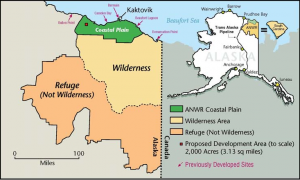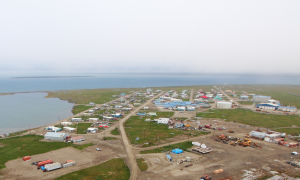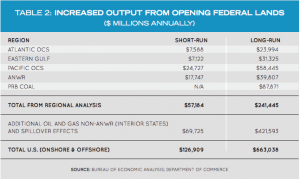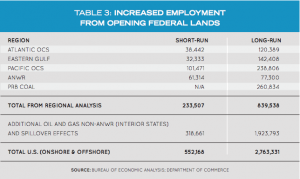The Arctic National Wildlife Refuge (ANWR) evokes stirring, iconic imagery in our minds: polar bears, glaciers, foraging herds of caribou on wind-swept plains.
The prospect of oil and gas companies entering the region’s landscape leaves many people unsettled and, to no surprise, proposals to open a portion of ANWR for energy exploration have faced fierce opposition.
But we need to recognize that those imagined scenes and our fears of defacing them do not comport with the reality of the territory under consideration. Developing ANWR’s energy resources—by some estimates more than 10 billion barrels of technically-recoverable oil—is actually a relatively low-risk proposal. And it’s one with local and state support.
The area with the potential to be opened to development is known as the 1002 area—so named for the section of the Alaska National Interest Lands Conservation Act that designated it for development consideration upon its passing in 1980. The 1002 area is a roughly 8-percent slice of ANWR, registering just 1.5 million acres out of a total of 19 million. The slice lies along the coastal plain abutting the Arctic Ocean’s Beaufort Sea.

Source: Alaska Department of Natural Resources
Risk vs. Reward
Human activity necessarily entails impacting the non-human world. But the costs of that impact should be evaluated from a humanity-focused framework. Energy development is a high-leverage activity that can continue to have a massive influence on the global population’s standard of living. Analyses of the long-term effect of development invariably show that wealth, as would be created by exploring ANWR, begets health. I’ll describe some of the benefits that will accrue from ANWR exploration below, but first allow me to address and hopefully allay some concerns people might have.
Though risks to the natural world of course exist, modern drilling is not an indubitable threat to the region’s ecology. ANWR’s frigid winter would serve as a safeguard of sorts, reducing the ecological impact of drilling. Arctic areas’ deep freezes, snow, and ice minimize potential impacts to tundra vegetation and conflicts with wildlife during the long winters by allowing the use of ice roads and ice pads on exploration sites, as BP and Conoco have demonstrated in other Arctic regions.
Forty years of drilling just to ANWR’s west in the Prudhoe Bay area show that energy exploration and a flourishing ecology are not mutually exclusive. To the chagrin of alarmists who warn that energy development harms critical wildlife, the population of the Central Arctic Caribou Herd that roams the area grew from 5,000 when drilling began in 1977 to a peak of nearly 70,000 around 2010 when a late-arriving spring caused a halving of the population, according to the Alaska Department of Fish and Game.
Information on drilling techniques and wildlife populations is unlikely to sway the environmentalist fringe whose standard of judgment is our preservation of a supposedly divine natural Earth, but it may give pause to the humanity-focused middle.
The Alaskan Perspective
Despite not being serviced by any permanent roads connecting it with the rest of Alaska, ANWR’s 1002 area includes the village of Kaktovik, which is home to around 250 people.

Source: http://www.groundtruthtrekking.org/
Contrary to what observers may expect given the media’s portrayal of rancor at the Dakota Access Pipeline site in Cannon Ball, North Dakota, the people who live closest to the proposed exploratory areas are strong proponents of liberalizing our economic lockdown of ANWR. Kaktovik local administrator Matthew Rexford testified before the Senate regarding the pending ANWR proposal in early November offering emphatic support. His full written testimony deserves reading, but here is the most poignant excerpt:
The Arctic Iñupiat will not become conservation refugees. We do not approve of efforts to turn our homeland into one giant national park, which literally guarantees us a fate with no economy, no jobs, reduced subsistence and no hope for the future of our people. We are already being impacted by restrictions of access to the federal lands for subsistence purposes – this is really disturbing to us since we have lived here long before there ever was a refuge designated.
As ANWR debates occur, the views of the Iñupiat who call the area home are oftentimes left out. The wishes of the people who live in and around the refuge’s coastal plain frequently are drowned out…My fellow Iñupiat and I firmly believe in a social license to operate, and perhaps no other potential project in the history of America has called for such a blessing from local indigenous peoples more than this one. Attempts to permanently block development in the 1002 – an area intentionally NOT designated as wilderness because of its oil and gas potential – is a slap in the face to our region and its people.
Furthermore, development has the unanimous support of Alaska’s Congressional delegation.
Senior Senator Lisa Murkowski has spearheaded the recent push on Capitol Hill. “Opening the 1002 Area to responsible oil and gas development will create thousands of new jobs, and those jobs will pay the types of wages that support families and put our kids through college,” said Murkowski earlier this month. “It will also generate tens of billions of dollars in revenues over the life of the fields for every level of government.”
Governor Bill Walker is a proponent of development as well. In a January press statement he wrote:
The state will do everything it can to provide the infrastructure needed to responsibly access the 1002 section of ANWR. Alaska has developed the seismic technology needed to focus on the most resource-rich portion of the area, allowing us to limit the footprint of activity in the region. With an oil pipeline that is three-quarters empty and an over $3 billion budget deficit, drilling in the 1002 would fill TAPS and bring much needed revenue to our state coffers.
To anyone familiar with the successes of energy development in other parts of Alaska and the state’s financial history, this unanimous advocacy for more leasing will come as no surprise.
Broad Economic Benefits
For Kaktovik and for the state the benefits are obvious. For the rest of the country the benefits aren’t as readily apparent. Fortunately, we have the December 2015 IER-commissioned study on the economic effects of opening federal lands to energy leasing to give us some insight.


According to the study’s findings, opening ANWR would have long-run benefits of nearly $40 billion to our economy and would result in an addition of over 77,000 jobs.
From an economic perspective energy exploration in ANWR is an open-and-shut case. But, of course, it isn’t economics that’s holding us back.
Nature for Nature’s Sake
As I wrote in an op-ed for Real Clear Energy, the economic flourishing of human beings isn’t the chief consideration of ANWR naysayers. They want to preserve nature for nature’s sake alone. The naysayers view humanity as an aspect of the terrestrial ecosystem, but not a superseding concern. Consider the words of the Alaska Wilderness League’s Kristen Miller, “Some places in our nation are simply too special, too sacred to drill—and the Arctic National Wildlife Refuge is one of them. This exhausted debate needs to end, once and for all.”
As the statement makes clear, from the perspective of the Alaska Wilderness League and its fellow travelers human beings simply do not have the moral license to utilize Earth’s natural endowment of resources. This vision is starkly at odds with human advancement.
Conclusion
ANWR is one of nature’s most generous endowments to us. By opening ANWR’s 1002 area to energy exploration, we would put that endowment to its best use. The benefits to our economy would be substantial and the risks are smaller than popularly imagined. The people of Alaska are already behind the idea—and have been for a long while. It’s time for the rest of us to catch up.
The post ANWR: What’s at Stake? appeared first on IER.
No comments:
Post a Comment